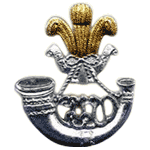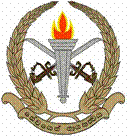The Ceylon Defence Force (CDF) was established in 1910 by the Ceylonese legislation Ceylon Defence Force Ordinance, which reformed the Ceylon Volunteer Force (CVF) that existed previously as the military reserve in the British Crown colony of Ceylon. At the time of forming it was only a reserve force but soon developed into a regular force responsible for the defence of Ceylon. The CDF was under the command of the General Officer Commanding, Ceylon of the British Army in Ceylon if mobilised. However mobilisation could be carried out only under orders from the Governor.
General Ranjan Wijeratne was a Sri Lankan planter and politician. He served in the Premadasa cabinet as Minister of Foreign Affairs and then Minister of Plantation Industries, while holding the office of State Minister for Defence.

The Sri Lanka Army is the oldest and largest of the Sri Lanka Armed Forces. The army was officially established as the Ceylon Army in 1949, though the army traces its roots back in 1881 when Ceylon Light Infantry Volunteers was created; the army was renamed as the 'Sri Lanka Army' when Sri Lanka became a republic in 1972. In 2024, the Army had approximately 150,000 personnel.

The Sri Lanka Artillery (SLA) is the artillery arm of the Sri Lanka Army. It is made up of ten regular regiments and two volunteer regiments. The SLA is headquartered at Panagoda Cantonment, Panagoda.
The Corp of Sri Lanka Engineers (SLE) is a combat support arm of the Sri Lanka Army which provides military engineering. It is made up of ten regular regiments and one volunteer regiment. Headquartered at Panagoda Cantonment, it is headed by the Centre Commandant.
The Sri Lanka Signals Corps (SLSC) is a combat support corps of the Sri Lanka Army, responsible for providing military communications, information technology and electronic warfare support. The corps is made up of a signals brigade, ten regular regiments and one volunteer regiment. It is responsible for installing, maintaining and operating all types of telecommunications equipment and information systems. It is headquartered at the Panagoda Cantonment.

The Sri Lanka Light Infantry (SLLI) is the oldest regiment in the Sri Lanka Army and the oldest infantry regiment in the army. It is made up of sixteen regular battalions and nine volunteer battalions, and is headquartered at the Panagoda Cantonment, Panagoda.

The Sri Lanka Sinha Regiment (SLSR) is an infantry regiment of the Sri Lanka Army; it is the second oldest infantry regiment in the army.
The National Cadet Corps is a youth organisation in Sri Lanka, sponsored by the Ministry of Defence, which operates in schools, and normally includes Army, Navy and Air Force sections. The corp is open for secondary school students on voluntary basis and its officers are government teachers and educational administrators, who serve as instructors. The Cadets are given basic military training in small arms and parades, as well as leadership training.

The Sri Lanka Army Volunteer Force (SLAVF) is the active-duty volunteer reserve force of the Sri Lanka Army. The SLAVF is separate from the Regular Force which consists of personal who are professional soldiers and its Regular Reserve, which comprises personal who have a mobilization obligation following their service in the regular army. The SLAVF consists of the volunteer force and the volunteer reserve; administration and recruitment of reserve personal is carried out by the Volunteer Force Headquarters in Shalawa, Kosgama which is headed by the Commandant of the Volunteer Force. It has a current strength of about 55,000 personnel. The SLAVF was known as the Ceylon Volunteer Force from 1949 to 1972 and the Sri Lanka Volunteer Force from 1972 to 1985.
The Ceylon Planters Rifle Corps was a regiment of the Ceylon Defence Force, which existed between 1900 and 1949. It was a volunteer (reserve) regiment based in Kandy, made up of only Europeans that were tea and rubber planters of the hills of Sri Lanka. The regiment deployed personnel to fight in the Second Boer War, the First, and Second World Wars.
The Rajarata Rifles was a former rifle regiment of the Sri Lanka Army. It was one of only three geographically based regiments in the Sri Lanka army. The cap badge of the Raja Rata Rifles shows the figure of a Bherunda Pakshiya.

The Sri Lanka Army Medical Corps (SLAMC) (Sinhala: ශ්රී ලංකා යුද හමුදා වෛද්ය බලකාය Shri Lanka Yuddha Hamuda Vayidya Balakaya) is a specialist corps in the Sri Lanka Army which specializes in military medicine and provides medical services to all army personnel and their families in war and in peace. It is made up of 4 regular units and one volunteer unit. Headquartered in Colombo, formally at army headquarters. The corps Cap badge depicting the Rod of Asclepius. General officers and senior officers of the SLMC wear gorget patches of maroon rather than of scarlet worn by other officers of similar rank.

The Sri Lanka Military Academy, commonly known simply as Diyatalawa, is the oldest military academy in Sri Lanka, and trains commissioned officers for the Sri Lanka Army. It is located in the garrison town of Diyatalawa in the central highlands of Sri Lanka. It has capacity to train more than 300 cadets.

General Deshamanya Joseph Everard Denis Perera, VSV, FCMI was a senior Sri Lanka Army officer who served as Commander of the Sri Lankan Army from 1977 to 1981. He was also the Sri Lankan High Commissioner to Australia, Chairman of the Securities and Exchange Commission and the Ceylon Tobacco Company and Chancellor of General Sir John Kotelawala Defence University. He envisioned for a women's corps in the army which resulted in the creation of the Sri Lanka Army Women's Corps in 1979. He is regarded as the father of the Sri Lanka Army Women's Corps.

General Tissa Indraka Weeratunga, VSV was a Sri Lankan general. He was the Commander of the Sri Lankan Army from 1981 to 1985 and the first General Officer Commanding (GOC) of the Joint Operations Headquarters (JOH), he was later Sri Lanka's High Commissioner to Canada from 1986 till 1990.

Colonel Candauda Arachchige Dharmapala, OBE, ED was a Sri Lankan politician. He was a Parliamentary Secretary to the Minister of Industries, Housing and Social Services and Member of Parliament for Hakmana. He also served as the permanent secretary to the Ministry of Defence, and as Security Adviser to President J. R. Jayewardene.
Lieutenant General Henry Vijaya Athukorale, VSV, psc, FBIM was a Sri Lankan senior army officer. He served as Commandant, Volunteer Force and Commander, Task Force Anti Illicit Immigration.
Colonel Derrick Nugawela was a Sri Lankan army officer, planter and banker.
Colonel Alan Tollence Nugawela (19??-2007) was a Sri Lankan army officer and a planter.









